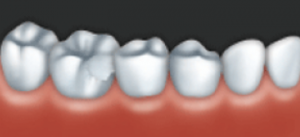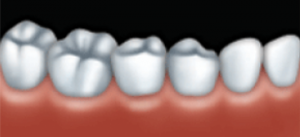Crowns
Restoring Damaged Teeth
If your tooth is damaged but not lost, a crown can be used to restore its shape, appearance and function. You may need a crown if you have a root canal, a large filling in a tooth or a broken tooth.
A crown, also called a cap, is a hollow, artificial tooth used to cover a damaged or decayed tooth. The crown restores the tooth and protects it from further damage. Crowns can also be used to cover a discoloured or misshapen tooth. A tooth that has been fixed with a crown looks and works very much like a natural tooth.
How a Crown is Done
- Local anesthetic is used.
- To make room for the crown, Dr Courchesne will file down the tooth that needs to be restored.
- An impression of the filed-down tooth and nearby teeth is taken. This impression is used to custom make your final crown. The crown is built using restorative material (material used for fillings) based on the impression. The final crown will be the right shape for your mouth.
- Until your final crown is ready, Dr Courchesne will place a temporary crown over the tooth that needs to be restored. The temporary crown is made from an impression of your tooth before it was filed down. It protects your tooth until the final crown is ready. A temporary crown may not have the same shape and colour as a final crown.
- On your next visit, Dr Courchesne will remove the temporary crown and put on the final one. She will st check to make sure the crown is the right fit, shape, colour and bite. If it is, the crown will be cemented into place.
These are the steps most commonly followed in making a crown, but your tooth may need special care. You may require orthodontic treatment, gum treatment or root canal treatment. It may take more than 2 visits or your appointments may be longer.
Different Types of Crowns
Crowns are made from various types of materials. Depending on which tooth needs a crown, Dr Courchesne will suggest a material, or combination of materials, that is right for you.
What Else Should I Know?
Crowns are strong and generally last for about 10 years or longer if you take good care of them. Brush and floss your crown, just like you clean your natural teeth. Crowns may not be as strong as your natural teeth. So like your natural teeth, remember not to bite down on hard objects or use your teeth to open or cut things.

A crown can be used to restore a damaged tooth.

To make room for the crown, your dentist files down the tooth to be restored.

The final crown is cemented into place. It looks and works very much like a natural tooth.
